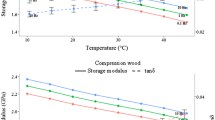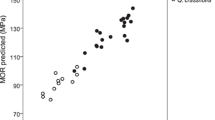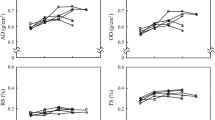Abstract
Development of optimal ways to predict juvenile wood stiffness, strength, and stability using wood properties that can be measured with relative ease and low cost is a priority for tree breeding and silviculture. Wood static modulus of elasticity (MOE), modulus of rupture (MOR), radial, tangential, and longitudinal shrinkage (RS, TS, LS), wood density (DEN), sound wave velocity (SWV), spiral grain (SLG), and microfibril angle (MFA) were measured on juvenile wood samples from lower stem sections in two radiata pine test plantations. Variation between inner (rings 1–2 from pith) and outer (rings 3–6 from pith) rings was generally larger than that among trees. MOE and MOR were lower (50%) in inner-rings than in outer-rings. RS and TS were higher (30–50%) for outer-rings than inner-rings, but LS decreased rapidly (>200%) from inner-rings to outer-rings. DEN had a higher correlation with MOR than with MOE, while MFA had a higher correlation with dry wood MOE than with MOR. SLG had higher significant correlation with MOE than with MOR. DEN and MOE had a weak, significant linear relationship with RS and TS, while MOE had a strong negative non-linear relationship with LS. Multiple regressions had a good potential as a method for predicting billet stiffness (R 2 > 0.42), but had only a weak potential to predict wood strength and shrinkage (R 2 < 0.22). For wood stiffness acoustic velocity measurements seemed to be the most practical, and for wood strength and stability acoustic velocity plus core density seemed to be the most practical measurements for predicting lower stem average in young trees.





Similar content being viewed by others
References
AS/NZS 1748 (1997) Timber-stress-graded—product requirements for mechanically stress-graded timber. Joint Australian/New Zealand Standard
AS/NZS 4063 (1992) Timber-stress-graded-in-grade strength and stiffness evaluation. Joint Australian/New Zealand Standard
Astley J, Harrington J, Tang S, Booker R (1997) Finite element modelling of wood performance. FRI bulletin no. 202, pp 39–41
Barber NF, Meylan BA (1964) The anisotropic shrinkage of wood: a theoretical model. Holzforschung 18:146–156
Booker RE, Sorensson CT (1999) New tools and techniques to determine mechanical wood properties. FIEA, wood quality symposium, emerging technologies for evaluating wood quality for wood processing, Melbourne, December 1999
Burdon RD, Kibblewhite RP, Walker JCF, Megraw RA, Evans R, Cown DJ (2004) Juvenile versus mature wood: a new concept, orthogonal to corewood versus outerwood, with special reference to Pinus radiata and P. taeda. For Sci 50(4):399–415
Carter P, Chauhan S, Walker J (2006) Sorting logs and lumber for stiffness using Director HM200. Wood Fiber Sci 38(1):49–54
Cave ID (1969) The longitudinal modulus of Pinus radiata. Wood Sci Technol 3:40–48
Cave ID (1972) A theory of the shrinkage of wood. Wood Sci Technol 6:284–292
Cave ID, Walker JCF (1994) Stiffness of wood in fast-grown plantation softwoods: the influence of microfibril angle. Forest Prod J 44(5):43–48
Cown DJ (1999) New Zealand pine and Douglas-fir: suitability for processing. Forest research bulletin no. 216, p 72
Cown D, van Wyk L (2004) Profitable wood processing—what does it require? Good wood! NZ J For 49(1):10–15
Cown DJ, McConchie DL, Young GD (1991) Radiata pine: wood properties survey. FRI-bulletin no. 50
Cown DJ, Haslett AN, Kimberley MO, McConchie M (1996a) The influence of wood quality on lumber drying distortion. Annales Sci For 53:1177–1188
Cown DJ, Walford B, Kimberley MO (1996b) Cross-grain effect on tensile strength and bending stiffness of Pinus radiata structural lumber. NZ J For Sci 25(2):256–262
Cown DJ, Hebert J, Ball R (1999) Modelling radiata pine lumber characteristics. Part 1: mechanical properties of small clears. NZ J For Sci 29(2):203–213
Donaldson LA (1996) Effect of physiological age and site on microfibril angle in Pinus radiata. IAWA J 17(4):421–429
Downes GM, Hudson IL, Raymond CA, Dean GH, Michell AJ, Schimleck LR, Evans R, Muneri A (1997) Sampling plantation eucalypts for wood and fibre properties. CSIRO Publishing, Collingwood, VIC, Australia, p 132
Downes GM, Nyakuengama JG, Evans R, Northway R, Blakemore P, Dickson RL, Lausberg M (2002) Relationship between wood density, microfibril angle and stiffness in thinned and fertilized Pinus radiata. IAWA J 23(3):253–265
Dumail JF, Castera P (1997) Transverse shrinkage in maritime pine juvenile wood. Wood Sci Technol 31:251–264
Dungey HS, Matheson AC, Kain D, Evans R (2006) Genetics of wood stiffness and its component traits in Pinus radiata. Can J For Res 36(5):1165–1178
Evans R (2003) Wood stiffness by X-ray diffractometry. In: Proceedings of the workshop, characterisation of the cellulosic cell wall, Grand, Lake, Colorado, 25–27 August 2003. University of Iowa and the Society of Wood Science and Technology, Madison
Evans R, Ilic J (2001) Rapid prediction of wood stiffness from microfibril angle and density. For Prod J 51:53–57
Evans R, Stuart SA, Van der Tour J (1996) Microfibril angle scanning of increment cores by X-ray diffractometry. Appita J 49(6):411–414
FibreGen (2006) Director ST300. Accessible from: http://www.fibrgen.com/products.html [accessed 01 November 2006]
Gapare WJ, Wu HX, Abarquez A (2006) Genetic control of the time of transition from juvenile to mature wood in Pinus radiata D. Don. Ann For Sci 63:871–878
Gapare WJ, Hathorn A, Kain D, Matheson AC, Wu HX (2007) Inheritance of spiral grain in the juvenile core of Pinus radiata D. Don. Can J For Res 37:116–127
Gapare WJ, Ivković M, Powell MB, McRae TA, Wu HX (2008) Genetics of shrinkage in juvenile trees of radiata pine from two test sites in Australia. Silvae Genet 57(3):145–151
Gu H, Zink-Sharp A, Sell J (2001) Hypothesis on the role of cell wall structure in differential transverse shrinkage of wood. Holz Roh-Werkst 59:436–442
Hansen JK, Roulund H (1998) Spiral grain in a clonal trial with Sitka spruce. Can J For Res 28:911–919
Harding KJ, Greaves BM, Gorsser C, Copley TR (2002) Juvenile wood quality in Pinus plantations: selecting clones with superior stiffness for structural timber. In: Nepveau G (ed) Fourth workshop: “connection between forest resources and wood quality: modelling approaches and simulation software”. Harrison Hot Springs, Canada, pp 94–103
Harris JM (1997) Shrinkage and density of radiata pine compression wood in relation to its anatomy and formation mode. NZ J For Sci 7:91–106
Harris JM, Meylan BA (1965) The influence of microfibril angle on longitudinal and tangential shrinkage in Pinus radiata. Holzforschung 19:144–153
Haslett AN, Simpson IG, Kimberley MO (1992) Utilisation of 25-year-old Pinus radiata. Part 2: warp of structural timber in drying. NZ J For Sci 21(2/3):228–234
Ilic J (2001a) Relationship among the dynamic and static elastic properties of air-dry Eucalyptus delegatensis R. Baker. Holz Roh-Werkst 59:169–175
Ilic J (2001b) Paddle-pop sticks—not just for licking. 27th forest products research conference, CSIRO forestry and forest products, Melbourne, Session 5, pp 45–46
Ilic J (2003) Dynamic MOE of 55 species using small wood beams. Holz Roh-Werkst 61(3):167–172
Ilic J (2004) Effect of juvenile core on softwood processing: results from recent resource and wood quality studies. In: Wood quality 2004—practical tools and new technologies to improve segregation of logs and lumber for processing. Albury, 5–6 August 2004
Johansson M (2003) Prediction of bow and crook in timber studs based on variation in longitudinal shrinkage. Wood Fiber Sci 35(3):445–455
Johansson M, Bäkström M (2002) Distortion models based on variation in material poperties. BC meeting. In: Nepveau G (ed) Fourth workshop: “connection between forest resources and wood quality: modelling approaches and simulation software”. Harrison Hot Springs, BC, pp 337–345
Kingston RST and Risdon CJE (1961) Shrinkage and density of Australian and other south–west Pacific wood. CSIRO division of forest products. Technical paper No. 13
Kumar S (2004) Genetic parameter estimates for wood stiffness, strength, internal checking and resin bleeding for radiata pine. Can J For Res 34:2601–2610
Kumar S, Jayawickrama KJS, Lee J, Lausberg M (2002) Direct and indirect measures of stiffness and strength show high heritability in a wind-pollinated radiata pine progeny test in New Zealand. Silvae Genet 51:256–261
Kumar S, Dungey HS, Matheson AC (2006) Genetic parameters and strategies for genetic improvement of stiffness in radiata pine. Silvae Genet 55(2):77–84
Li CC (1981) Path analysis—a primer. The Boxwood Press, Pacific Groove
Mack JJ (1979) Australian methods for mechanically testing small clear specimens of timber. CSIRO, division of building research technological paper (second series) No. 31
Matheson AC, Yang JL, Spencer DJ (1997) Breeding radiata pine for improvement of sawn timber value. In: Zhang SY, Gosselin R, Chauret G (eds) Timber management toward wood quality and end-product value. Proceedings of CTIA/IUFRO international wood quality workshop. IV–19, Quebec
Matheson AC, Gapare WJ, Ilic J, Wu HX (2008) Inheritance and genetic gain in wood stiffness in radiata pine measured acoustically in young standing trees. Silvae Genetica 57(2):56–64
McKinley R, Ball R, Downes G, Fife D, Gritton D, Ilic J, Koehler A, Morrow A, Pongracic S (2003) Resource evaluation for future profit: wood property survey of the green triangle region. http://www.fwprdc.org.au/menu.asp?id=36&lstReports=16 [accessed 01 November 2006]
Megraw RA, Leaf G, Bremer D (1998) Longitudinal shrinkage and microfibril angle in loblolly pine. In: Butterfield BG (ed) Proceedings of IAWA/IUFRO workshop on “microfibril angle in wood”. University of Canterbury, New Zealand, pp 27–61
Megraw R, Bremer D, Leaf G, Roers J (1999) Stiffness in loblolly pine as a function of ring position and height and its relationship to microfibril angle and specific gravity. In: Nepveu G (Ed) Proceedings of the third workshop IUFRO S5.01.04 “Connection between silviculture and wood quality through modeling approaches and simulation software”, La Londe-Les Maures, France, 5–12 September, pp 341–349
Meylan BA (1967) Cause of high longitudinal shrinkage in wood. For Prod J 18:75–78
Pang S (2002) Predicting anisotropic shrinkage of softwood Part 1: theories. Wood Sci Technol 36:75–91
Panshin AJ, de Zeeuw C (1980) Textbook of wood technology, 4th edn. p 772
SAS Institute Inc (2005) SAS System 8.02. Online reference manual. SAS Institute Inc., Cary
Tsehaye A, Walker JCF (1996) Spiral grain in Canterbury Pinus radiata: within- and between-tree variations and effect on mechanical properties. New Zealand J For Sci 25(3):358–366
Walker JCF, Nakada R (1999) Understanding corewood in some conifers: a selective review on stiffness and acoustics. Int For Rev 1:251–259
Wu HX, Ivković M, McRae TA, Powell MB (2005) Breeding radiata pine to maximise profit from solid wood production: summary report PN01.1904. Forest and wood products research and development corporation, Melbourne. http://www.fwprdc.org.au/menu.asp?id=36&lstReports=16
Xu P, Walker JCF (2004) Stiffness gradients in radiata pine trees. Wood Sci Technol 38(1):1–9
Xu P, Donaldson L, Walker J, Evans R, Downes G (2004) Effects of density and microfibril orientation on the vertical variation of low-stiffness wood in radiata pine butt logs. Holzforschung 58(6):673–677
Ying L, Kretschmann DE, Bendtsen BA (1994) Longitudinal shrinkage in fast-grown loblolly pine plantation wood. For Prod J 44(1):58–62
Zobel BJ, Sprague JR (1998) Juvenile wood in forest trees. Springer, Berlin, p 300
Acknowledgments
This work forms part of the Juvenile Wood Initiative, a collaborative project between CSIRO, STBA, FWPRDC, and Arborgen. Dr. Colin Matheson, Andrew Morrow, John Owen, David Spencer, Adam Redman and Winston Liew of CSIRO, Peter Buxton of HVPP and Jill Duff of STBA contributed to acoustic measurements on standing trees, billet sampling, sample preparation for shrinkage and static wood stiffness measurement.
Author information
Authors and Affiliations
Corresponding author
Rights and permissions
About this article
Cite this article
Ivković, M., Gapare, W.J., Abarquez, A. et al. Prediction of wood stiffness, strength, and shrinkage in juvenile wood of radiata pine. Wood Sci Technol 43, 237–257 (2009). https://doi.org/10.1007/s00226-008-0232-3
Received:
Published:
Issue Date:
DOI: https://doi.org/10.1007/s00226-008-0232-3




